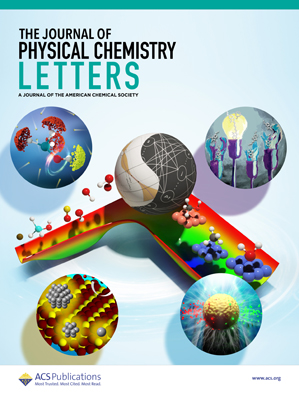在参数驱动的玻色量子器件上模拟化学动力学的路线图
IF 4.6
2区 化学
Q2 CHEMISTRY, PHYSICAL
引用次数: 0
摘要
化学反应通常由反应物到生成物的反应通量跨越双阱自由能势垒来描述。动力学通常涉及势垒重越和量子效应,如隧穿、零点能量运动和干涉,而传统的速率理论(如过渡态理论)并不考虑这些因素。在本研究中,我们研究了使用参数驱动玻色超导克尔猫装置模拟反应动力学的可行性。这种方法可以控制定义双阱自由能曲线的参数,以及温度和反应坐标与非反应自由度热浴之间的耦合强度等外部因素。我们通过展示原型基准模型系统(如丙二醛的氢键二聚体和 DNA 碱基对)中质子转移反应的动力学,证明了这一方案的有效性。本文章由计算机程序翻译,如有差异,请以英文原文为准。

A Roadmap for Simulating Chemical Dynamics on a Parametrically Driven Bosonic Quantum Device
Chemical reactions are commonly described by the reactive flux transferring the population from reactants to products across a double-well free energy barrier. Dynamics often involves barrier recrossing and quantum effects like tunneling, zero-point energy motion, and interference, which traditional rate theories, such as transition-state theory, do not consider. In this study, we investigate the feasibility of simulating reaction dynamics using a parametrically driven bosonic superconducting Kerr-cat device. This approach provides control over parameters defining the double-well free energy profile, as well as external factors like temperature and the coupling strength between the reaction coordinate and the thermal bath of nonreactive degrees of freedom. We demonstrate the effectiveness of this protocol by showing that the dynamics of proton-transfer reactions in prototypical benchmark model systems, such as hydrogen-bonded dimers of malonaldehyde and DNA base pairs, could be accurately simulated on the currently accessible Kerr-cat devices.
求助全文
通过发布文献求助,成功后即可免费获取论文全文。
去求助
来源期刊

The Journal of Physical Chemistry Letters
CHEMISTRY, PHYSICAL-NANOSCIENCE & NANOTECHNOLOGY
CiteScore
9.60
自引率
7.00%
发文量
1519
审稿时长
1.6 months
期刊介绍:
The Journal of Physical Chemistry (JPC) Letters is devoted to reporting new and original experimental and theoretical basic research of interest to physical chemists, biophysical chemists, chemical physicists, physicists, material scientists, and engineers. An important criterion for acceptance is that the paper reports a significant scientific advance and/or physical insight such that rapid publication is essential. Two issues of JPC Letters are published each month.
 求助内容:
求助内容: 应助结果提醒方式:
应助结果提醒方式:


